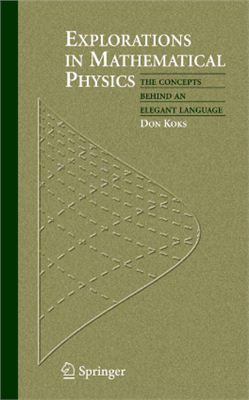Springer, 2006. - 544 pages.
Have you ever wondered why the language of mode physics centers on geometry? Or how quantum operators and Dirac brackets work? What a convolution really is? What tensors are all about? Or what field theory and lagrangians are, and why gravity is described as curvature?
This book takes you on a tour of the main ideas forming the language of mode mathematical physics. Here you will meet novel approaches to concepts such as determinants and geometry, wave function evolution, statistics, signal processing, and three-dimensional rotations. You'll see how the accelerated frames of special relativity tell us about gravity. On the jouey, you'll discover how tensor notation relates to vector calculus, how differential geometry is built on intuitive concepts, and how variational calculus leads to field theory. You will meet quantum measurement theory, along with Green functions and the art of complex integration, and finally general relativity and cosmology.
The book takes a fresh approach to tensor analysis built solely on the metric and vectors, with no need for one-forms. This gives a much more geometrical and intuitive insight into vector and tensor calculus, together with general relativity, than do traditional, more abstract methods.
Have you ever wondered why the language of mode physics centers on geometry? Or how quantum operators and Dirac brackets work? What a convolution really is? What tensors are all about? Or what field theory and lagrangians are, and why gravity is described as curvature?
This book takes you on a tour of the main ideas forming the language of mode mathematical physics. Here you will meet novel approaches to concepts such as determinants and geometry, wave function evolution, statistics, signal processing, and three-dimensional rotations. You'll see how the accelerated frames of special relativity tell us about gravity. On the jouey, you'll discover how tensor notation relates to vector calculus, how differential geometry is built on intuitive concepts, and how variational calculus leads to field theory. You will meet quantum measurement theory, along with Green functions and the art of complex integration, and finally general relativity and cosmology.
The book takes a fresh approach to tensor analysis built solely on the metric and vectors, with no need for one-forms. This gives a much more geometrical and intuitive insight into vector and tensor calculus, together with general relativity, than do traditional, more abstract methods.

